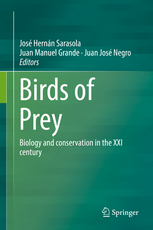This book, edited by JH Sarasola (UNLPam, Argentina), JM Grande (CONICET, Argentina) and JJ Negro (EBD-CSIC), provides the state-of-the-art on most of the topics involved in the ecology and conservation of birds of prey. With chapters authored by the most recognized and prestigious researchers on each of the fields, this book will become an authorized reference volume for raptor biologists and researchers around the world.
https://www.springer.com/gp/book/9783319737447
Welcome
Welcome to the official website of the Doñana Biological Station (EBD-CSIC)...

The Doñana Biological Station: EBD-CSIC
The Doñana Biological Station is a public Research Institute belonging to the Spanish Council for Scientific Research CSIC in the area of Natural Resources...

Mission
Our fundamental mission is to carry out multidisciplinary research of the highest standard directed to understanding the way in which biodiversity is generated, maintained and deteriorates, as well as the consequences of its loss...

Our methods
We apply many techniques within a multidisciplinary framework, from molecular genetics to remote sensing, and from modelling to physiological and isotopic analyses...

Monitoring the environment
Monitoring biodiversity at the Doñana Natural Space cover a wide range of communities, including both terrestrial and aquatic organisms...

Aims
Our aims include the study of the ecological and evolutionary processes by combining field work, mathematical and statistical models and physiological and genetic analysis...
 Outstanding
Outstanding
Birds of Prey Biology and conservation in the XXI century
 News
News
 Open Call for Research Projects in ICTS-Doñana!
Open Call for Research Projects in ICTS-Doñana!
 Las altas temperaturas están provocando que las lagunas y las marismas de Doñana pierdan agua rápidamente
Las altas temperaturas están provocando que las lagunas y las marismas de Doñana pierdan agua rápidamente
 Traffic noise causes lifelong harm to baby birds
Traffic noise causes lifelong harm to baby birds
 Illegal wildlife trade, a serious problem for biodiversity and human health
Illegal wildlife trade, a serious problem for biodiversity and human health
 Urbanization and loss of woody vegetation are changing key traits of arthropod communities
Urbanization and loss of woody vegetation are changing key traits of arthropod communities
The loss of woody areas is linked to a decline in the duration of the activity period, a higher tolerance to drought, and less dispersal capacity in both groups.





